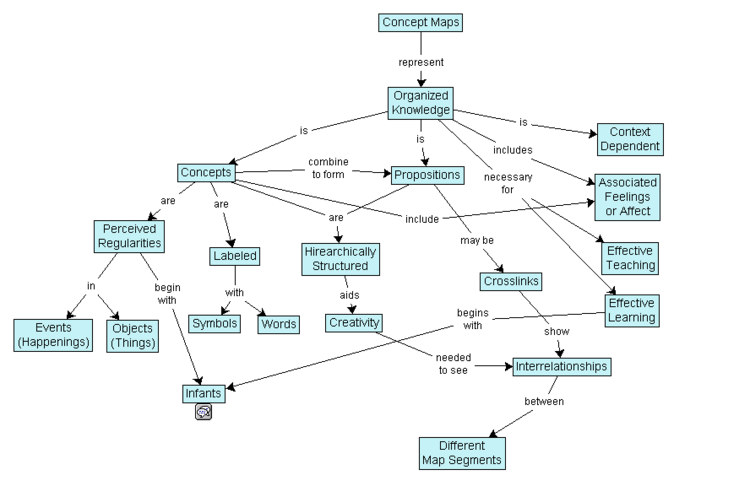Concept map facts for kids

A concept map is a special kind of drawing. It shows how different ideas, or "concepts," are connected to each other. People use concept maps to organize what they know and to understand new information better.
Imagine you have many ideas about a topic. A concept map helps you put them into boxes or circles. Then, you draw arrows between the boxes to show how the ideas are linked. These arrows often have words on them, like "causes," "needs," or "is an example of." This helps explain the relationship between the ideas.
Making these maps is called concept mapping. It's a great way to visualize how different pieces of information fit together.
Contents
What's the Difference from Other Maps?
Concept maps are similar to other visual tools but have some key differences.
Concept Maps vs. Mind Maps
You might have heard of mind maps. Both concept maps and mind maps help you organize thoughts. However, there's a big difference:
- Mind maps usually start from one main idea in the middle. All other ideas branch out from that single center, like a tree.
- Concept maps are more flexible. They can have many main ideas or "hubs." Ideas can connect to many other ideas, not just one central point. This makes them useful for showing complex relationships.
How Concept Maps Started
Concept mapping was created in the 1970s by a professor named Joseph D. Novak at Cornell University. He and his team wanted to see how students learned science. They found that concept maps were a great way to show what students understood.
Novak's ideas were based on the work of David Ausubel. Ausubel believed that what you already know is super important for learning new things. He said, "The most important single factor influencing learning is what the learner already knows."
Novak taught young students, even those as young as six, to make concept maps. They would use them to answer questions like "What is water?" or "What causes the seasons?" He believed that learning new ideas means connecting them to what you already have in your mind.
Over time, concept maps became popular. They are now used to help people learn in many subjects. They also help experts share their knowledge in schools, government, and businesses.
How Are Concept Maps Used?
Concept maps are very helpful tools in many situations.
For Learning and Studying
- Note-taking: You can use concept maps to take notes. They help you find the main ideas in a book or lesson and see how they connect.
- Summarizing: After reading something, you can make a concept map to quickly summarize the key points and their relationships.
- Brainstorming: When you need new ideas, concept maps can help you think creatively and connect different thoughts.
- Understanding: They help you see the big picture of a topic and how all the parts fit together.
- Learning how to learn: Making concept maps helps you think about your own thinking and how you learn best.
For Sharing Ideas
- Communicating: Concept maps can make complex ideas easier to explain to others.
- Teamwork: They help groups of people share what they know and work together on projects.
- Keeping knowledge: Businesses use them to record what their experienced employees know before they retire.
Concept maps are a powerful way to organize information, learn new things, and share ideas clearly.
See also
 In Spanish: Mapa conceptual para niños
In Spanish: Mapa conceptual para niños
- CmapTools
- Concept inventory
- Conceptual framework
- Semantic network
- Level of measurement
- Group concept mapping
- Information model
- Idea networking
- List of concept- and mind-mapping software
- Nomological network
- Personal knowledge base


